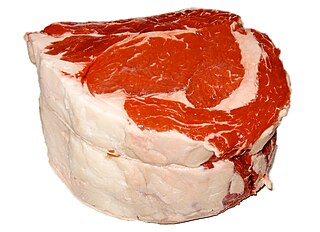
Beef is the culinary name for meat from cattle, particularly skeletal muscle. Humans have been eating beef since prehistoric times. Beef is a source of high-quality protein and nutrients.

A hamburger is a sandwich consisting of one or more cooked patties of ground meat, usually beef, placed inside a sliced bread roll or bun. The patty may be pan fried, grilled, or flame broiled. Hamburgers are often served with cheese, lettuce, tomato, onion, pickles, bacon, or chiles; condiments such as ketchup, mayonnaise, mustard, relish, or "special sauce"; and are frequently placed on sesame seed buns. A hamburger topped with cheese is called a cheeseburger.

Escherichia coli O157:H7 is a serotype of the bacterial species Escherichia coli and is one of the Shiga toxin–producing types of E. coli. It is a cause of disease, typically foodborne illness, through consumption of contaminated and raw food, including raw milk and undercooked ground beef. Infection with this type of pathogenic bacteria may lead to hemorrhagic diarrhea, and to kidney failure; these have been reported to cause the deaths of children younger than five years of age, of elderly patients, and of patients whose immune systems are otherwise compromised.

A slaughterhouse, also called abattoir, is a facility where animals are slaughtered, most often to provide food for humans. Slaughterhouses supply meat, which then becomes the responsibility of a packaging facility.
Ground beef, minced beef or beef mince is beef that has been finely chopped with a knife or a meat grinder or mincing machine. It is used in many recipes including hamburgers and spaghetti Bolognese.

Different cattle feeding production systems have separate advantages and disadvantages. Most cattle in the US have a diet that is composed of at least some forage. In fact, most beef cattle are raised on pasture from birth in the spring until autumn. Then for pasture-fed animals, grass is the forage that composes all or at least the great majority of their diet. Cattle fattened in feedlots are fed small amounts of hay supplemented with grain, soy and other ingredients in order to increase the energy density of the diet. The debate is whether cattle should be raised on diets primarily composed of pasture (grass) or a concentrated diet of grain, soy, corn and other supplements. The issue is often complicated by the political interests and confusion between labels such as "free range", "organic", or "natural". Cattle raised on a primarily forage diet are termed grass-fed or pasture-raised; for example meat or milk may be called grass-fed beef or pasture-raised dairy. However, the term "pasture-raised" can lead to confusion with the term "free range", which does not describe exactly what the animals eat.
The term meat industry describes modern industrialized livestock agriculture for production, packing, preservation and marketing of meat. In economics, it is a fusion of primary (agriculture) and secondary (industry) activity and hard to characterize strictly in terms of either one alone. The greater part of the entire meat industry is termed meat packing industry- the segment that handles the slaughtering, processing, packaging, and distribution of animals such as cattle, pigs, sheep and other livestock.

Beef cattle are cattle raised for meat production. The meat of mature or almost mature cattle is mostly known as beef. In beef production there are three main stages: cow-calf operations, backgrounding, and feedlot operations. The production cycle of the animals start at cow-calf operations; this operation is designed specifically to breed cows for their offspring. From here the calves are backgrounded for a feedlot. Animals grown specifically for the feedlot are known as feeder cattle, the goal of these animals is fattening. Animals not grown for a feedlot are typically female and are commonly known as replacement heifers. While the principal use of beef cattle is meat production, other uses include leather, and beef by-products used in candy, shampoo, cosmetics, insulin and inhalers.

Peeps is a 2005 novel by Scott Westerfeld revolving around a parasite which causes people to become cannibalistic and repelled by that which they once loved. It follows the protagonist, Cal Thompson, as he lives with this parasite and tries to uncover a possible threat to the whole population of the world. The apocalyptic threat to the world that begins in Peeps continues in The Last Days, which featured some of the same characters.
Foods included in raw animal food diets include any food that can be eaten raw, so including raw, unprocessed meats/organ-meats/raw eggs, raw dairy, and aged, raw animal foods such as century eggs, fermenting meat/fish/shellfish/dairy(such as kefir), as well as, to a lesser extent, nuts/sprouts/plants/fruits, but generally not raw grains, raw beans, raw soy etc., because of digestibility and toxicity issues and also because paleolists tend to reject neolithic or domesticated foods. Raw foods on such diets have not been heated at temperatures above 104 °F (40 °C). “Raw Animal Foodists” believe that foods cooked above this temperature have lost much of their nutritional value and are harmful to the body. Smoked meats are frowned upon by many Raw-Omnivores. Some make a distinction between hot-smoked and cold-smoked.

Bovine spongiform encephalopathy (BSE), commonly known as mad cow disease, is a neurodegenerative disease of cattle. Symptoms include abnormal behavior, trouble walking, and weight loss. Later in the course of the disease the cow becomes unable to move. The time between infection and onset of symptoms is generally four to five years. Time from onset of symptoms to death is generally weeks to months. Spread to humans is believed to result in variant Creutzfeldt–Jakob disease (vCJD). As of 2018, a total of 231 cases of vCJD have been reported globally.
An outbreak of the Escherichia coli O157 bacterium occurred in South Wales in 2005. It was the largest outbreak of E. coli O157 in Wales and the second largest in the UK. 157 cases were identified in the outbreak; 31 people were hospitalized, and one child, 5-year old Mason Jones, died. Most of the 157 cases identified were children, attending 44 different schools across four different local authorities – Bridgend, Merthyr Tydfil, Caerphily and Rhondda Cynon Taf. Of those infected, 109 cases were identified as a strain of E. coli O157 unique to this outbreak.
Enteroinvasive Escherichia coli (EIEC) is a type of pathogenic bacteria whose infection causes a syndrome that is identical to shigellosis, with profuse diarrhea and high fever. EIEC are highly invasive, and they use adhesin proteins to bind to and enter intestinal cells. They produce no toxins, but severely damage the intestinal wall through mechanical cell destruction.

Meat on the bone, also called bone-in meat is meat that is sold with some or all of the bones included in the cut or portion, i.e. meat that has not been filleted. The phrase "on the bone" can also be applied to specific types of meat, most commonly ham on the bone, and to fish. Meat or fish on the bone may be cooked and served with the bones still included or the bones may be removed at some stage in the preparation.

Raw meat generally refers to any type of uncooked muscle tissue of an animal used for food. In the meat production industry, the term ‘meat’ refers specifically to mammalian flesh, while the words ‘poultry’ and ‘seafood’ are used to differentiate between the tissue of birds and aquatic creatures.

Escherichia coli is a gram-negative, rod-shaped bacterium that is commonly found in the lower intestine of warm-blooded organisms (endotherms). Most E. coli strains are harmless, but pathogenic varieties cause serious food poisoning, septic shock, meningitis, or urinary tract infections in humans Unlike normal flora E. coli, the pathogenic varieties produce toxins and other virulence factors that enable them to reside in parts of the body normally not inhabited by E. coli and to damage host cells. These pathogenic traits are encoded by virulence genes carried only by the pathogens.
The 1993 Jack in the Box E. coli outbreak occurred when 732 people were infected with the Escherichia coli O157:H7 bacterium originating from contaminated beef patties. The outbreak involved 73 Jack in the Box restaurants in California, Idaho, Washington, and Nevada, and has been described as "far and away the most infamous food poison outbreak in contemporary history." The majority of the victims were under 10 years old. Four children died and 178 other victims were left with permanent injury including kidney and brain damage.

The United Kingdom BSE outbreak was a widespread occurrence of bovine spongiform encephalopathy that affected cows in the United Kingdom in the 1980s and 1990s. Over four million cows were destroyed in an effort to contain the outbreak, and 177 people died after contracting variant Creutzfeldt-Jakob disease (vCJD) through eating infected beef. A political and public health crisis resulted, and British beef was banned from export to numerous countries around the world, with some bans remaining in place until as late as 2012.













